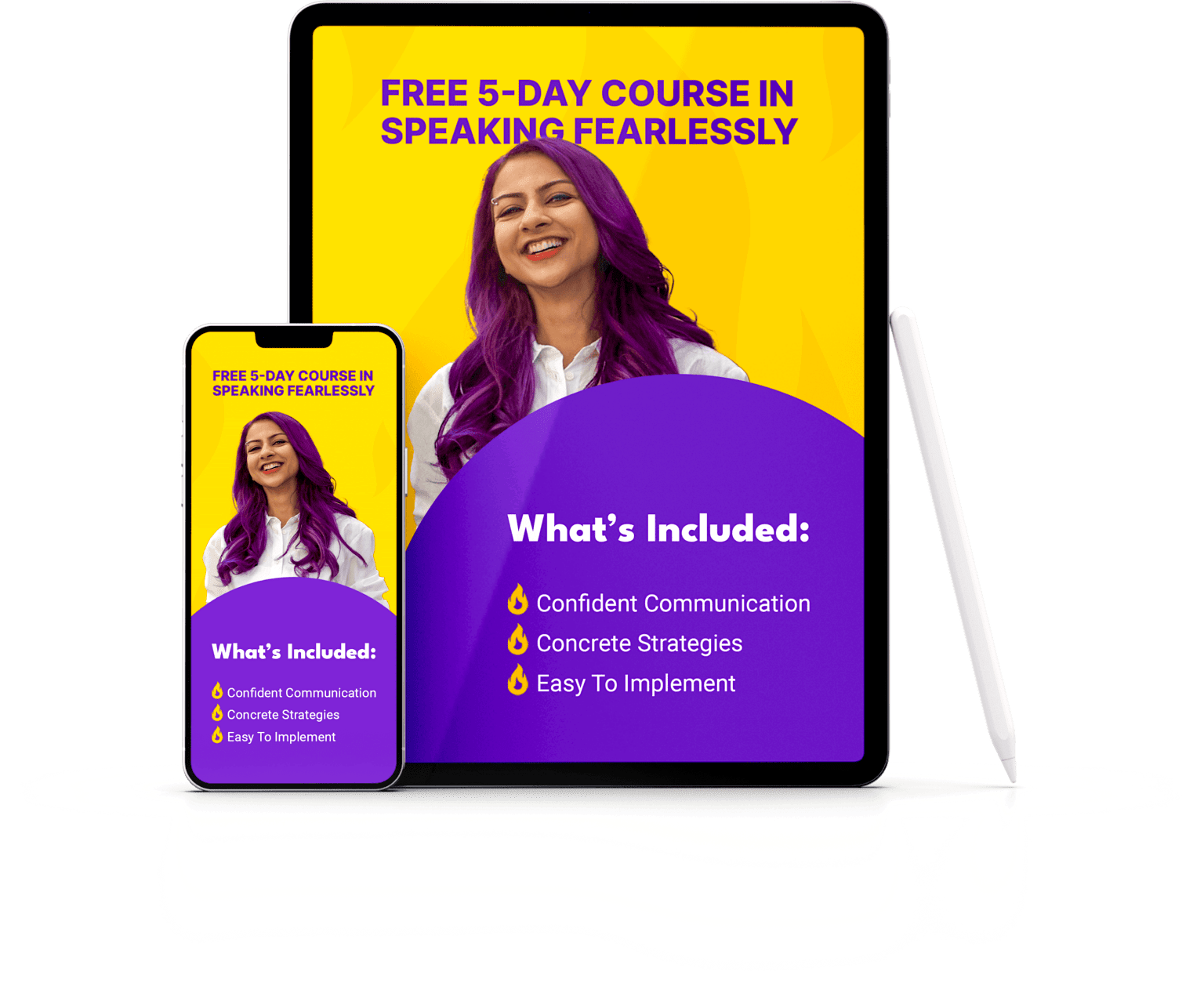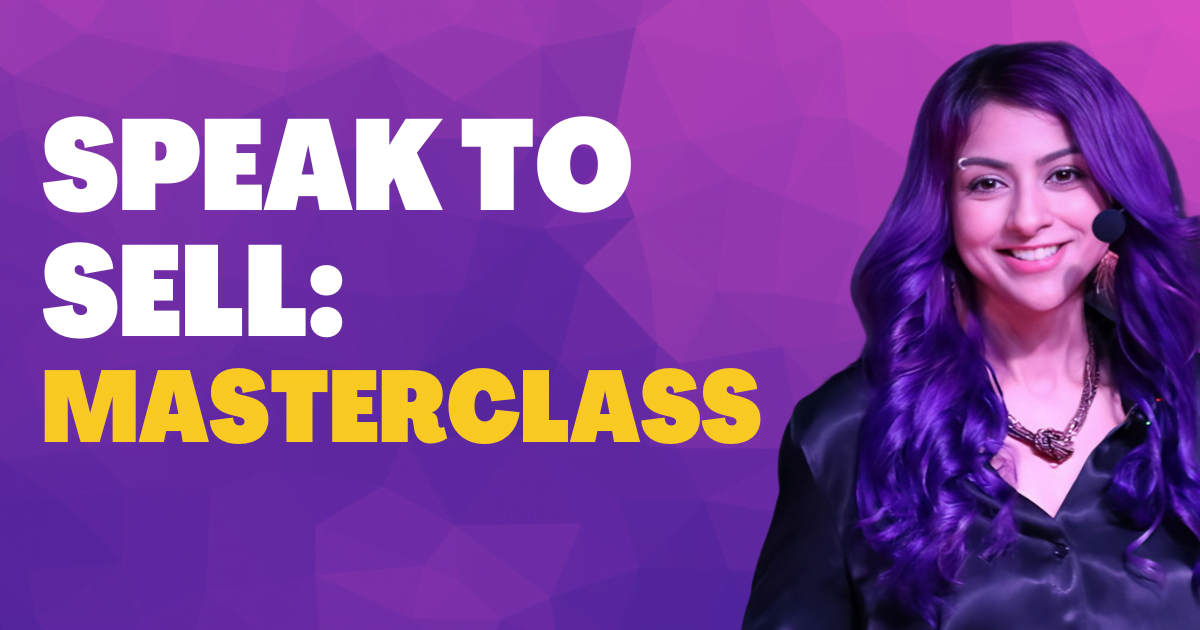Voice trembling, heart racing and the world blurring as you address your audience: if you’ve ever felt this way when speaking in public, this one’s for you.
Whether you’re presenting a proposal, pitching an idea or talking to investors, experiencing feelings of nervousness and fear is normal.
The good news is – you can create a plan to change all of that in 2024.

Imagine cultivating a voice brimming with confidence, feeling your heartbeat with excitement and being ready to make an impact in the world as you put your thoughts and ideas out there.
And imagine turning every speaking engagement into an opportunity to help, influence – and even transform people.
I’m going to share with you the best public speaking books that I’ve selected for you, to move towards that stage in 2024.
What’s Inside:
Top Public Speaking Books to Become A Better Speaker in 2024
I’m excited to share with you the top 10 recommendations from my reading list, with the hope that these books have an impact on upgrading your speaking skills.
In this article, I’ll share with you:
- My top public speaking book recommendations.
- A glimpse into the wisdom and actionable advice that each book promises.
- Recommendations from these books to target specific speaking skills.
Let’s get started.
1. The Definitive Book of Body Language by Barbara Pease and Allan Pease

Yes – the first book on my list is about body language.
That’s deliberate – because when you speak to an audience, non-verbal communication can be even more important than the words you say.
Did you know that research indicates that non-verbal communication is five times more impactful than words? When words and gestures do not match, people tend to subconsciously rely on non-verbal cues and ignore verbal content.
What I loved about this book is how the Peases explain the science behind body language and the importance of specific gestures.
You’ll learn:
- What eyes hide (or reveal).
- How to use hand gestures (including handshakes).
- How smiles, laughter and humor can influence the people we talk to.
- Arm signals (helpful when you speak with a person or to a large audience).
- How body language varies across cultures. This is crucial if you work with global clients or address a multicultural audience.
Often, people reading body language make the mistake of interpreting a solitary gesture in isolation.
For instance, when someone is scratching their head it may mean multiple things: sweating, uncertainty, dandruff, forgetfulness, or lying – depending on other gestures that are happening at the same time. That’s why the Peases recommend understanding gestures together – “in clusters” – and deriving the meaning.
Here’s another tip they share in the book: a palm-up gesture shows your openness and a palm-closed-and-forefinger-pointed gesture annoys your audience. So, use your hands in the palm-up gesture to be seen as friendly and trustworthy.
When and where do you practice reading body language?
“Practice this for 15 minutes every day”, this book suggests. It also observes that the airport is a great place to practice reading body language. It’s a place where you’ll see people expressing a variety of body language – eagerness, anger, sorrow, happiness, impatience and many other emotions.
This book has helped me understand people better. I highly recommend you read this one. You’ll feel more comfortable striking a conversation with strangers as well as addressing large audiences.
2. Talk like TED by Carmine Gallo

The name of this book should’ve been “How to Understand People and Yourself”. This isn’t just for delivering TED talks – it’s a book filled with secrets that lead to success in speaking and in life.
What I loved most is how it helps us understand the basic principle of successful communication using the Greek philosopher Aristotle’s communication theory. From there it breaks down some of the all-time great TED talks and shares the principles used to deliver them impactfully.
Through “Talk like TED, The 9 Public-speaking Secrets of the World’s Top Minds”, I’ve gained insights into human psychology (like how smoking is more of a sign of inner turmoil and has less to do with nicotine addiction), popular theories (such as “10,000 hours of practice” and “rule of three”), how to deliver jaw-dropping moments and much more.
This book is also a cleverly disguised self-help book. Once you read some of the stories and TED talks – you won’t need another motivational book.

Credit: Photo by TED
Whether you’re preparing for a TED talk or not, don’t miss out on this book – it’ll teach you how to have the same level of impact as that of a TED talk any time you address an audience.
3. Confessions of a Public Speaker by Scott Berkun
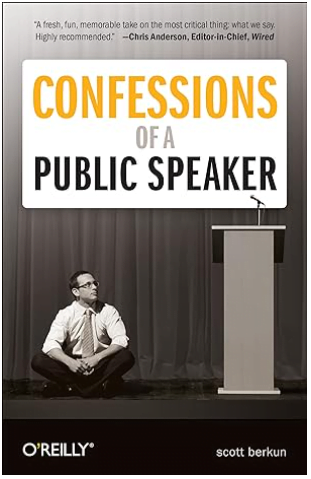
This is an awesome, funny and honest memoir from someone who has delivered more than 600 talks. I found myself nodding and saying “YES, THAT’S EXACTLY IT!” at Berkun’s insights into what makes public speaking so scary and yet immensely rewarding and fulfilling.
My biggest takeaway from Confessions of a Public Speaker is the understanding that our level of fear is relative. For instance, “if you are chased by a tiger on the way to giving a presentation, you’re likely to find the presentation not nearly as scary”.
Think about it for a moment.
“Our perspective on what things are worth fearing would have been freshly calibrated with such an incident – even if you are imagining it”.
This dispels the popular myth that public speaking is scarier than the prospect of death.

Credit: photo source on Giphy
This book also gives you practical tips such as:
- What you should do to reduce physical stress before addressing an audience, and
- How to improve a presentation that you were not able to deliver with impact.
You can’t go wrong with these firsthand lessons from the public speaking battlefield.
4. Just Listen by Mark Goulston
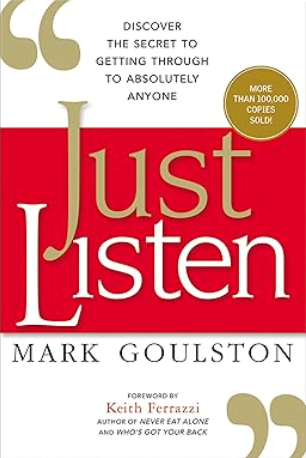
The one thing that a lot of people forget when they’re speaking in public: to listen.
Most inexperienced speakers make this mistake: they think of every talk or presentation as a one-way lecture or conversation. But that’s the best way to bore your audience and lose making the most of the speaking opportunity.

Credit: Photo source on Giphy
That’s exactly why I included Just Listen on my list. Almost everyone has experienced the trauma of not being able to get through and get favorable responses from people in positions of power. The realization that you can do this quite effectively, not by talking but by LISTENING – was like a light-bulb moment for me.
My key takeaway is how Goulston explains the concept of “The Persuasion Cycle”. Goulston teaches the art of persuasion through this cycle – how you need to get people to go:
- From resisting to listening
- From listening to considering
- From considering to willing
- From willing to actually doing, and finally
- From doing to feeling glad that they did and continuing to take action.
The biggest benefit I noticed is how easily and quickly you can put Goulston’s suggestions and techniques into practice.
If you’re someone who believes that you can “talk your way out of any situation”, well, perhaps there’s a better way – you can “listen (and persuade) your way out of any situation.”
5. If I Understood You, Would I Have This Look on My Face? by Alan Alda
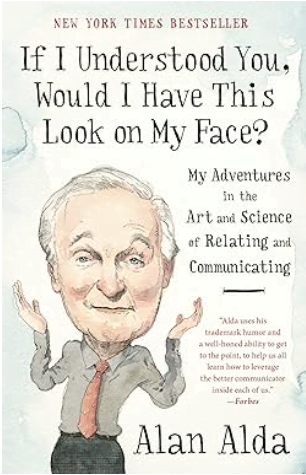
With a title like that – I couldn’t resist picking this book up. But I’m happy to report that it absolutely lived up to its promise of being wacky, interesting and super helpful. This is a treasure trove of Alda’s lived experiences in communicating with thousands of people during his prolific career as an actor, author, screenwriter, podcast host and director.
If I were to explain how this book can help you in one sentence, it would be: it teaches you how you can relate to others and get better at reading them.
You’ll enjoy reading the nuances of communication:
- How listening can be contagious.
- How to listen with your eyes and feelings.
- How empathy plays a role in effective communication.
… and so much more.
You won’t be able to resist practicing the Mirror Exercise as soon as you read it – an exercise you do with another person by intently observing them and mirroring every move they slowly make. The idea here is to be able to relate to the other person, and to make you realize that “The person who’s communicating something is responsible for how well the other person follows them.”

Credit: Photo source on Giphy
Another point I liked from this book is the understanding of why we tend to use jargon when addressing an audience and why we should not.
Jargon is something that’s known by a small group of people. Using it makes us feel good – like the pleasure of speaking a secret language. However, we tend to use it without realizing that it may actually make it harder for the other person to understand.
I bet you’ll enjoy Alda’s unique way of sharing his wisdom in this book as much as I did.
6. Think Faster, Talk Smarter by Matt Abrahams
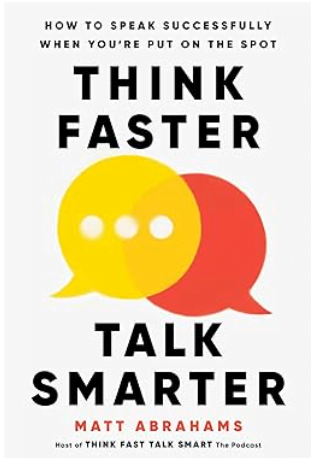
Mark Twain, who made most of his income from speaking (not writing), said, “There are two types of speakers: those that are nervous and those that are liars.”
Most of us are certainly not as brilliant as Mark Twain – so we can take consolation in the fact that pretty much every speaker feels nervous. That anxiety hits an all-time high when you’re asked to say something without much time to prepare.
Situations where you’re asked to:
- Answer a question posed by your boss’ boss in a team meeting.
- Address a critical last-minute issue by a client.
- Introduce yourself at a networking event.
Or (this one’s my favorite) when you’re answering tricky questions at the end of your presentation.
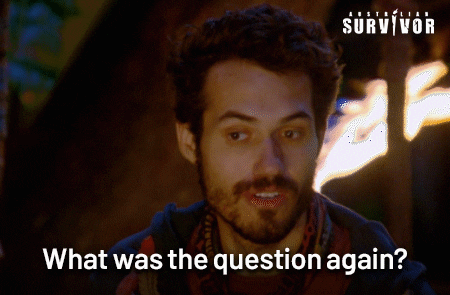
Credit: Photo source on Giphy
Think Faster, Talk Smarter: How to Speak Successfully When You’re Put on the Spot is one of the books that’ll help you get past that anxiety by training yourself to think faster in the moment when you’re put on the spot.
You’ll enjoy the systematic approach Abrahams takes in this book as he explains how to develop a faster thinking process:
- How to manage the anxiety of public speaking.
- Why being good enough is great in spontaneous talking.
- How to take back control when you’re put on the spot by changing your mindset.
- How to stay quiet (and listen) when it isn’t the right time to say something.
- How to have a roadmap when speaking spontaneously.
- And finally, six applications of a faster thinking process to specific situations where you’re likely to be put on the spot.
Articulating well on the spot is a skill that’ll serve you for life – whether you’re speaking to an audience or answering what you want for dinner. This book will get you there.
7. The Story Factor by Annette Simmons
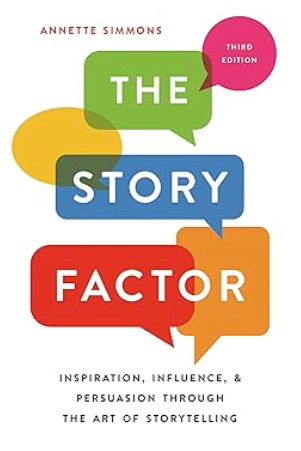
We’re hardwired to listen to a story – they’ve helped us survive for over 300,000 years.
Stories are also known to light up more of our brains and release oxytocin. Stories help us forge connections by becoming relatable to our audience. Finally, stories paint a picture – which we can easily digest as we’re visual creatures.
The Story Factor: Inspiration, Influence, and Persuasion through the Art of Storytelling shows you the six types of stories you can use to influence your audience whenever you talk:
- ”Who I Am” Stories
- ”Why I Am Here” Stories
- ”The Vision” Story
- ”Teaching” Stories
- ”Values-in-Action” Stories
- “I Know What You Are Thinking” Stories
Simmons dives into the basics of storytelling and then goes on to talk about how to effortlessly weave stories into your talks.

Credit: Photo source on Giphy
She answers questions like:
- What’s a story.
- How stories help where facts fail.
- How to tell a good story.
- How to use storytelling as a tool of influence.
What I liked the most in this book is how Simmons goes into the specifics of how to influence people who are unwilling to listen to you, who might be unconcerned or even unmotivated. Simmons categorizes people into 11 types from our perspective (Heroes and Villains, The Truly Evil, Selling Justice, The Cynical and so on) – some based on situations and some based on branding that’s prevailing in the society. Then she alludes to the approach by taking multiple example scenarios and diving deep into human psychology – thereby allowing the reader to take lessons by themselves.
8. Presence by Amy Cuddy
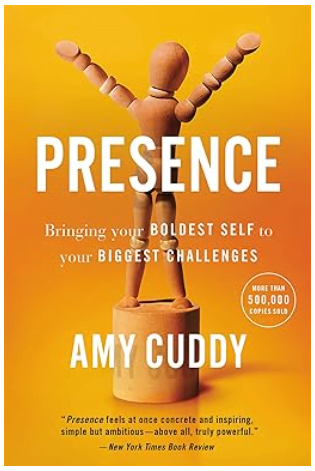
“We know it when we feel it, and we know it when we see it, but presence is hard to define. On the other hand, most of us are quite good at describing the lack of it.”
When you walk into a room (or enter a Zoom meeting), you bring your presence with you. It’s a way of getting people to either sit up and take notice – or completely ignore that you’re there.
Presence: Bringing Your Boldest Self to Your Biggest Challenges helps you develop your presence so that you’re never ignored in any situation. Presence – or what some in the leadership coaching world call “executive presence” is built on showing:
- Confidence without arrogance.
- Comfort without laziness.
- Passionate enthusiasm without foolhardiness.
I enjoyed one of Cuddy’s examples – of a young aspiring actor, Will, being called for a Hollywood film audition by his agent:

Credit: Photo source on Giphy
Will reaches the place of audition, completely overwhelmed by the enormity of the occasion. While waiting anxiously, he remembers his friend’s suggestion to practice the Wonder Woman power pose for a whole 120 seconds. He goes to the men’s room and strikes the pose, even though he isn’t sure it works.
That power pose brings about such a massive change in him that he aces the audition and goes on to grab the role – in the Oscar-nominated film, Wild.
Presence, as Cuddy says, comes by believing in and owning our own stories.
You’ll learn how to hack your body language and mindset to build a positive presence – which will serve you well in any meeting, presentation or podcast.
9. The Charisma Myth by Olivia Fox Cabane
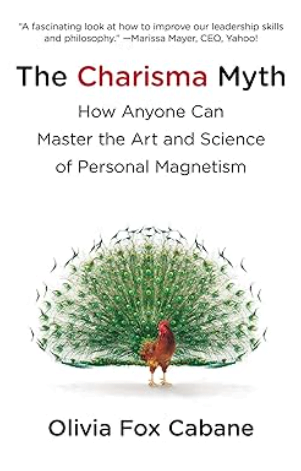
We’ve all come across someone who has left an unforgettable impression on us. We were so enamored by them that we wanted “to be like them”.
When you speak in public, being charismatic will attract your audience to not just pay attention but keep listening all the way to the end.
The Charisma Myth: How Anyone Can Master the Art and Science of Personal Magnetism is THE book to learn how to unlock that charisma.
Guess who features in the opening section?
Norma Jean Baker aka Marilyn Monroe!
Charisma is our ability to:
- Be fully present.
- Project power and authority.
- Show warmth towards others.
This book doesn’t just give you principles and rules – it has tons of actionable tips to develop your charisma, like:
Three quick tips to gain an instant charisma boost in conversation:
- Lower the intonation of your voice at the end of your sentences.
- Reduce how quickly and how often you nod.
- Pause for two full seconds before you speak.
There isn’t just one way to be charismatic. You can learn to bring magnetism to your talk by showing different kinds of behaviors like demonstrating confidence, optimism, expressive body language and a passionate voice.

Credit: Photo source on Giphy
The best part of this book, which I‘m sure you’ll find quite helpful, is the “Charisma Exercises” section. Cabane suggests specific exercises for every type of concept she teaches you in this book:
- Destigmatizing discomfort to change.
- Neutralizing negativity that stops you from developing your charisma.
- Reframing and rewriting reality.
- Stretching your comfort zone
…and more.
If you’ve been hiding in the shadows, ignored by those who have the power to positively impact your career and business – this book is required reading.
10. The 10 Stories Great Leaders Tell by Paul Smith
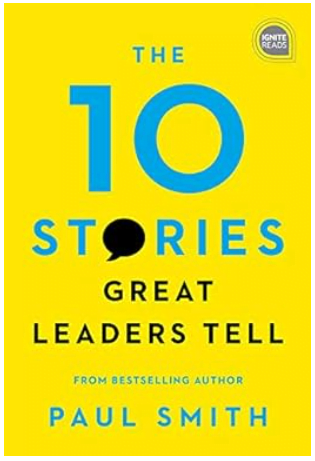
This is one of the shortest and yet one of the most valuable books I’ve read.
Why “stories” by leaders, you ask, and not “principles” or “ideas” or “speeches”?
Smith explains the reasons:
- Stories are timeless.
- Stories can be contagious.
- Stories can be inspirational.
- Stories can be applied to any situation.
- Stories are memorable so lessons are easier to recall.
But where a lot of my clients feel lost is – what stories should they be telling? And when? To whom?
That’s why I love this book – it doesn’t just show you the different types of stories you can tell – like the founder’s story or a customer story – but it also explains where these stories would be the most useful to share.
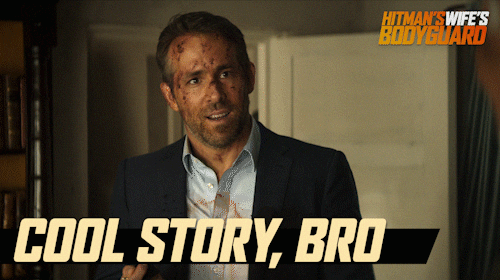
Credit: Photo source on Giphy
For example, if you’re an entrepreneur, crafting an origin story will serve you well. That way, you’ll always have a great response to the question “Tell me about yourself”. If you’re a CXO implementing an organizational change, you may want to develop a case-for-change story.
And if you’re leading sales and marketing, you may want to have a solid customer story to share with new prospects.
For each story type, Smith shares the elements that make it a great story and tips for you to craft your own stories.
Bonus: Recommendations From These Books To Improve Your Public Speaking Skills
Here is a list of the key strategies you can implement today to improve your public speaking skills – based on the books in this list.
1. Non-verbal Communication

Credit: Photo source on Giphy
From: The Definitive Book of Body Language
- Practice mirroring: This refers to subtly mimicking the other person’s posture and gestures. This helps you build rapport and trust with them.
- Assume steepling fingers post: This refers to holding your hands in front of your body with fingers touching at the tips, forming an upward-pointing V shape. This gesture shows the confidence and authority of the person on the subject. Interestingly, this gesture is likely to be assumed by an expert while talking to an audience, as well as while listening to another expert. However – don’t overuse it! This has come under fire for being overused and has unfortunately now become a cliché.

Credit: Photo by Karolina Grabowska on Pexels
From: Presence
- Practice power posing: Cuddy suggests that standing tall with open arms for two minutes before your presentation can boost confidence and presence. According to her, research indicates that adopting power poses for just two minutes can increase testosterone levels (the hormone associated with assertiveness), decrease cortisol levels (the hormone associated with stress and anxiety) and activate brain regions associated with power and reward.
- Speak from your authentic self: Cuddy says that when we sincerely express our positive emotions, our non-verbal communication matches our words – creating trust in our audience.
- Practice non-verbal interventions to feel confident: When you find yourself being hard on yourself and feeling low, intervene using non-verbal exercises such as deep breathing, smiling or sitting up straight.
2. Delivery

Credit: Photo source on Giphy
From: Talk Like TED
- Vary your pitch, pace, and volume: This prevents your voice becoming monotonous – engaging your audience better.
- Use pauses strategically: Pauses can add emphasis and give your audience time to think.
- Speak with clarity and articulate well: When you enunciate your words clearly and emphasize important words in a sentence – you’ll deliver with better impact.
From: Think Faster, Talk Smarter
- Organize your thoughts before speaking: When you prepare your presentation with a clear structure (a strong beginning, middle and end), you’ll be able to deliver concisely – and your audience will understand you better.
- Speak from notes, not a full script: Using a script can make you sound unnatural, like a radio announcer. Using notes allows you to be more flexible and spontaneous.
- Practice your presentation aloud beforehand: This helps you get comfortable with the material and identify areas that need improvement – so you’ll be able to deliver with confidence.
3. Storytelling

Credit: Photo source on Giphy
From: The Story Factor
- Use gestures, body language and facial expressions: Use gestures and body language to effectively create images in your audience’s mind. Use facial expressions to communicate the right emotions.
- Use irrelevant details: Although this may come as a surprise, Simmons argues that “irrelevant” details add texture to your story and make it interesting.
- Connect before you convince: Stories are used to convince your audience about a point you’re making. But first, you need to be able to connect with them. Only then will you be able to convince them – argues Simmons. So find what’s common between you and your audience and lead your story with that – it helps them connect with you.
From: The 10 Stories Great Leaders Tell
- Which story you tell is more important than how you tell it: This may be counterintuitive, but Smith argues that the relevance of the story to your audience is the critical factor.
- Choose from 10 types of stories: Smith shares 10 types of stories and suggests that you won’t have to look beyond these in your role as a leader. He’s arrived at this conclusion from his 300+ in-depth, one-on-one interviews with CEOs, leaders and executives from 25+ countries.
- Use the following structure for your story: A hook, context, challenge, conflict or struggle, resolution, lesson and recommendation. Smith claims this will create an impactful story every time.
4. Active Listening

Credit: Photo source on Giphy
From: Just Listen
- Pay attention to both verbal and non-verbal cues: Both of these are essential so that you can understand whether your audience is still with you.
- Get the other person to listen by lowering their anger or fear: You can do this by being genuinely interested in knowing what’s bothering them. This shows them that you care to listen, and they reciprocate.
- Be curious about people: Goulston says that by putting yourself in other people’s shoes you’ll be able to feel empathy towards their situation. This makes you curious to know what’s really happening with them, and thus listen better.
From: If I Understood You, Would I Have This Look on My Face?
- Listening should be your step 0: Alda has discovered from his work with thousands of scientists and doctors that listening should begin before you even start trying to communicate.
- Listen, in order to be listened to: It indeed is a give-and-take situation – people listen more deeply to the person listening to them. This may seem like common sense, but it’s easy to miss being mindful of this in your interactions with people.
5. Confidence and Charisma

Credit: Photo source on Giphy
From: Confessions of a Public Speaker
- Confidence, not perfection, is the goal: As a coach, Berkun says he finds that most people who are worried about their presentation aren’t ready to practice! Confidence comes only from practice, he confirms. Aiming for perfection makes it harder to practice because of the stress of trying to be perfect.
- Practice micro-presentations: Treat many of your planned meetings (1-1 or with groups) as micro-presentations. For each, prepare beforehand with a structure (a beginning, middle and end) and reflect on your performance after it’s over. This will help you improve consistently and thus build your confidence.
- Use a confidence monitor during your presentations: It’s a computer monitor placed on the floor in front of you on the stage – which your audience can’t see. It shows you the notes or illustrations you need to refer to while presenting. When you know that you won’t forget an important point, you’ll gain confidence.
From: The Charisma Myth
- Create charismatic mental states to reach your full charisma potential: Visualizing yourself nailing a difficult presentation, feeling gratitude for all the things you have and feeling compassionate towards others (as well as yourself). This helps you maximize your potential to be charismatic.
- Understand different styles of charisma: There are four types – Focus charisma (your 100% focus on the other person), Visionary charisma (your ability to inspire people), Kindness charisma (the acceptance and warmth you radiate) and Authority charisma (the perception of power). Decide on which one comes naturally to you and develop it.
- Follow the golden rule: People like people who are like them. Work on connecting with people to make them feel like you’re like them, suggests Cabane.
Conclusion

Credit: Photo source on Giphy
These are 10 of the best books on public speaking – and speaking in general – that I can recommend to you.
Now that you’ve got a glimpse inside each book, I’d recommend making a prioritized list to read and implement those strategies, techniques, and tips in 2024.
Make 2024 the year where your speaking skills transform you into a more successful manager, leader or entrepreneur.
If you need help to accelerate that journey, reach out to me. I’m here to help!

